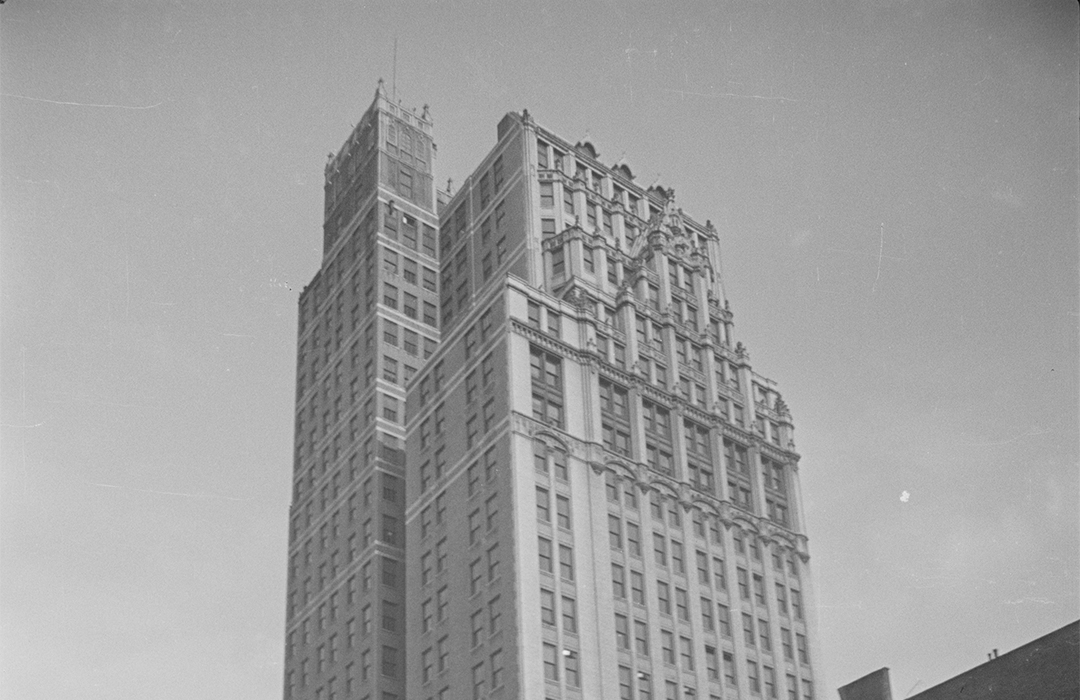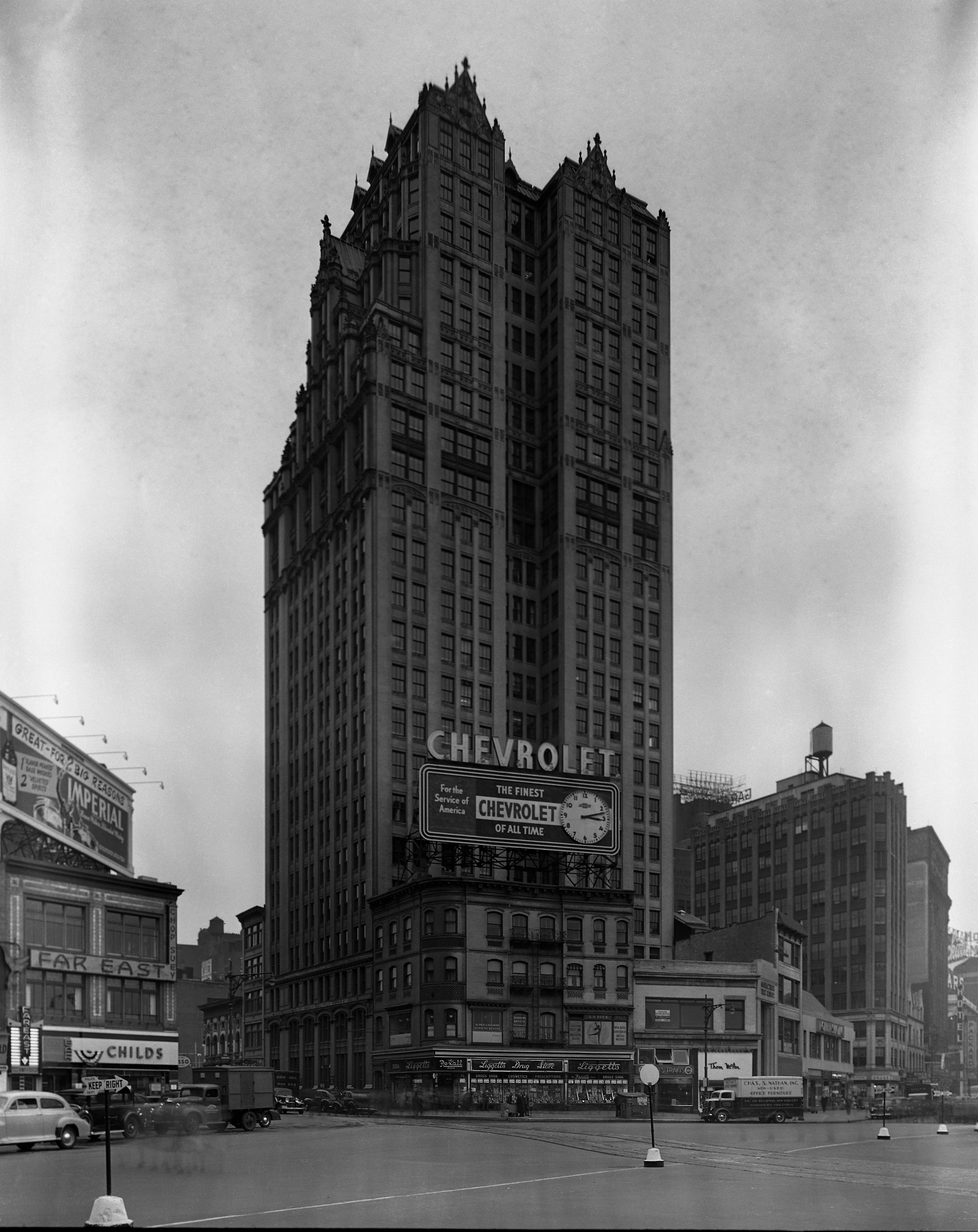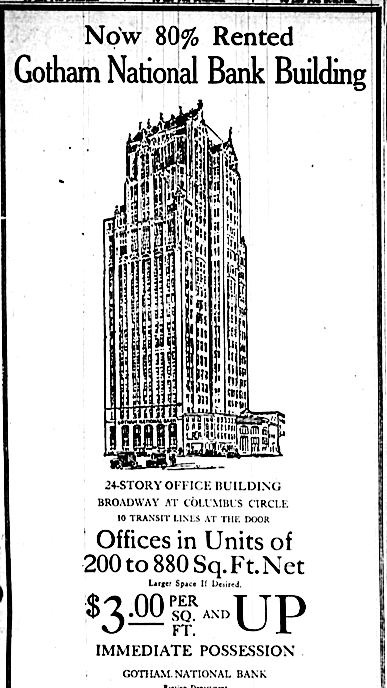
Gotham Savings Bank Building – 307-309 West 59th Street
by Tom Miller
For years, the Gotham Savings Bank operated from the small building at 13 Columbus Circle at the corner of 59th Street. By 1919, the institution had outgrown the space and was leasing the upper portion of 1123 Broadway for its bookkeeping department. On June 21, 1919, the Record & Guide reported that the bank had purchased the old garage at 303 West 59th Street, abutting its current building. “It is understood that the property will be improved with a banking building which will provide much needed additional space,” said the article.
The bank, however, had loftier aspirations. Seven months later, on January 6, 1920, the New-York Tribune reported that the Gotham National Bank had purchased the four-story building at 307-309 West 59th Street. The purchase “gives the Gotham bank a combined frontage of 84 feet on Fifty-ninth Street, upon which will be erected a twenty-two-story office building, connected with and having an entrance through the present bank building at Broadway and Columbus Circle,” explained the article. The construction was predicted to cost $2 million—closer to $30.4 million in 2024.
The architectural firm of Sommerfeld & Steckler filed plans within the week. Kenneth Murchison was designated the supervising architect. On February 15, the New-York Tribune reported that the bank had decided on a “departure from the conventional methods employed in building construction” by foregoing a general contractor and placing the bank’s vice-president, Clarence S. Weller “in direct charge of all building operations.”
The bank was hit with extortion demands that resulted in newspapers reporting a scandal and accusing the bank of graft.
The arrangement may have contributed to unions believing the project was an easy target. The bank was hit with extortion demands that resulted in newspapers reporting a scandal and accusing the bank of graft. In a letter to the editor of The New York Times on November 15, 1920, Clarence S. Weller said the newspaper had done “an injustice” to the Gotham National Bank. He stressed, “not only did the bank refrain from making the payment of a single dollar, but at no time did it contemplate making any payment whatsoever.” The unions involved were indicted by the State Banking Commission.
As the building neared completion on February 27, 1921, The New York Times described its architecture as “in the Gothic type.” (In truth, it was a blend of neo-Gothic and Art Deco styles.) Saying it “stands out as a conspicuous architectural ornament in the locality,” the article noted, “The set-back effect provides an attractive tower, the effect of which is heightened by the Gothic design.” Interestingly, the low building on Columbus Avenue between 59th and 60th Streets was preserved, and its banking room extended into the new structure. An arcade connected the two buildings.
The Gotham Bank occupied the two lower floors, and the upper floors were rented. Well before construction was completed, tenants had signed leases. One of the first was the Graphophone Company, which took the top eight floors. Several other tenants were automobile-related (this stretch of Broadway was known as Automobile Row), like H. & D. Motors, Hudson Tire and Rubber Company, Aero-Auto Supply, Standard Motor Equipment Company, Dodge Brothers, Cleveland Automobile Company, Pitts Motor Car Repair and Sales Corporation, Chandler Motor Car Company, and the Toquet Carburetor Corporation. Non-automobile-related tenants included the Motion Picture Photographers Association; Begley, Steen & Burnside; the Bureau of Credits; and the Northern Ball Bearing Company, among others.
Only months after moving into its headquarters, on February 22, 1922, the Columbia Graphophone Company declared bankruptcy. The failure was, perhaps, as devastating to the Gotham Bank, which lost its tenant of eight full floors.
Several other tenants were automobile-related…
On April 16, 1925, The New York Times reported that the Gotham Bank had merged with Manufacturers Trust Company. Just two days later, The Sun reported, “For $3,750,000 the Schulte Cigar Stores Company purchased the Gotham Bank Building, a twenty-four story structure 303-309 West Fifty-ninth street…The sale includes the two-story taxpayer 1819-1821 Broadway, or 13 Columbus Circle.”
Prohibition ended in December 1933, and nine months later, Columbus Circle businessmen were no doubt elated when Pat Shine’s, an Irish pub, opened on the ground floor of the Gotham Bank Building.
In 1946, urban planner Robert Moses proposed erecting a convention center and sporting complex (“a new Madison Square Garden”) on Columbus Circle. After years of discussion, the New York Coliseum project was approved in 1953. The structure would stretch from 58th to 60th Street, eliminating 59th Street from Columbus Circle to Columbus Avenue. Before construction could begin in 1954, two blocks of structures, including the Gotham Bank Building, had to be razed. The Gothic-Art Deco skyscraper is nearly forgotten today.
Tom Miller is a social historian and blogger at daytoninmanhattan.blogspot.com
BUILDING DATABASE
Dig into UWS Social History




